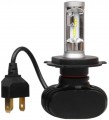The angle of illumination provided by the LED car lamp (see “Type”). This parameter, as a rule, is selected by the manufacturer taking into account the purpose (see above) and other features of the lamp’s use.
Models for headlights (see “Purpose”) usually have fairly large coverage angles - from
270° to
360°(the latter cover almost the entire sphere, with the exception of the space behind the base). This is necessary to work effectively with headlight reflectors. Theoretically, the larger the illumination angle, the more efficiently the reflector area is used and the higher the actual brightness; however, in practice this difference is not so noticeable, and much depends on the specific configuration of the reflectors. A specific type of LED headlight lamps are models with an illumination angle of about 60°, in which the concentration of the light beam is ensured by the built-in reflectors of the lamp itself.
In turn, in auxiliary lighting, the angles are selected for the specific specialization of the lamp and are usually at least
120°(maximum - the same 360°).
The maximum continuous lamp operation time. This indicator is quite approximate and the probability that the lamp will work during this period is approximately 1 in 3. This is due to the measurement technique: a control batch of lamps is used until 63.2% of them fail, the resulting time and indicated as "maximum service life". However, the Tc data compared to the B3 guaranteed life (see above) provides a good estimate of the overall lamp life and its ability to last beyond the guaranteed life.

